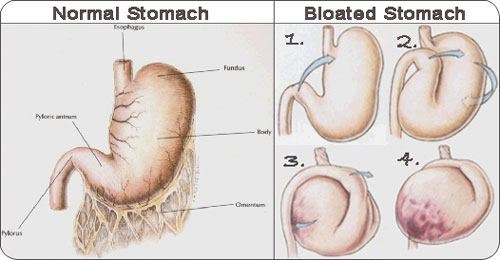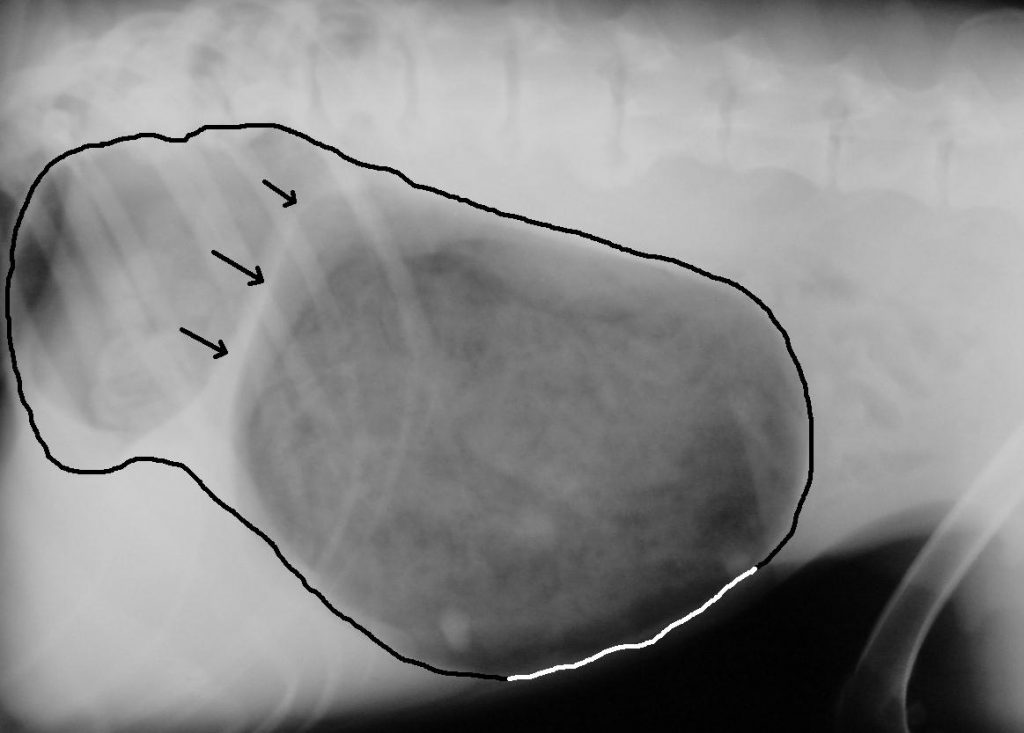Frequency and Causes
The stomach torsion is with about 20% one of the most frequent causes of death of the great dane, while it has the same prevalence in all colour groups and in males and females. This might indicate, that the heritability of this disease is rather low, whereas studies have found out, that the risk for a stomach torsion increases if there are cases in the relatives of the dog. But this has probably rather anatomical and physiological reasons instead of a special gene, which causes the stomach torsion.
According to a study of Glickmann et al. from 2000 about 42,5% of all great danes will suffer a stomach torsion in the course of a lifetime. But if it is detected early by the owner and the dog is being operated the chances of survival are rather high. About two third of the dogs survive the operation.
There exist several studies about the stomach torsion nowadays and some of them contradict each other. Only in a few points the studies agree with each other: Especially big dogs are affected with a deep thorax and the risk of a bloat increases with age (because of the slackening of the conjunctive tissue). Furthermore nervous and stress-susceptible dogs are more often affected. There are also several external factors which influence the risk of a stomach torsion. It appears more often in the summer than in the winter and mostly in the late evening and often stressful situations precede the bloat.
According to the way of feeding there are a variety of statements in the different studies. Some recommend to feed with a raised bowl, others consider it a risk factor, because dogs who eat very quickly might swallow more air this way. Also considering the composition of the food there are different results in the studies. To prevent a stomach torsion it anyway seems to be recommended to feed twice a day and not to use food which swells up a lot or has a huge amount of dietary fiber. Furthermore the food has to be fresh and hygienically immaculate, which refers to BARF as well as dry food, which should not be soaked too long in water. And the dog should rest one to two hours after the feeding and not be stressed before and after the feeding.

What happens during a stomach torsion?
A stomach torsion is always preceded by an accumulation of gas in the stomach. It is not known yet why this happens, but decomposition is under suspicion, which might be caused by bacteria in the food. Also the individual composition of the stomach- and intestinal bacteria flora might be causative. Stressful situations and/or a stress-susceptible temper can also disturb the motalitiy (the movement) of the stomach and lead to a longer stay of the stomach contents and therefore a gasification. But there also frequently occur bloats with an empty stomach.
After gas is accumulated in the stomach it will turn around its own axis, which can happen easily since it only hangs on two points in the abdomen, the oesophagus and the small bowel. A weak conjunctive tissue (for example in old dogs, or in hypertype danes with lots of loose skin), a deep thorax and overstretched ligaments caused by feeding one big portion a day promote the rotation of the stomach. The stomach is being closed by the rotation and even more gas is being accumulated like in a balloon. This leads to a strangulation of the blood vessels and in a short time to a circulatory collapse. Furthermore the stomach wall, the spleen and other organs die if they are not provided with blood anymore.
The bloat is an acute life threatening situation, which has to be treated as quick as possible, for the dog will otherwise die in a very gruesome way in a few hours.
This is why great dane owners should always know where the next animal hospital with emergency service is situated, in the place of residence as well as when they go to holidays. When the dog is taken to the hospital it will first be X-rayed, to diagnose the stomach torsion for sure. Then its circulation is stabilized with an infusion and pressure is taken from the abdomen by letting gas out of the stomach with a cannula. Only then the abdomen will be opened in narcosis and the stomach is rotated back. If there is necrotic tissue it will be removed. The stomach will be fixed by sewing it to the abdomen wall because otherwise the risk of another torsion is 80%.

If the operation has been successful the dog has to stay in the animal clinic for a few days to be monitored. Because of the strangled blood vessels and the toxins, which have been produced by necrotic tissue, there is still a high risk of a circulatory collapse. Even months after a stomach torsion dogs can still have cardiac arrhythmias. Furthermore the dog has to be started feeding very slowly and its digestion has to be monitored. When the dog is back home it has to be spared for some weeks and be fed in small portions. Usually the recovery is quick.
How can you recognize a stomach torsion?
Every great dane owner has to be prepared for this emergency case, which can happen even if all precautions have been taken. An attentive dog owner will easily recognize a stomach torsion. The affected dog is restless, it doesn’t want to lay down and relax. It often tries to vomit, but only saliver is coming, since the stomach is closed. The dog will pant and stand with a crouched back, because it feels strong pain in its abdomen. Only after a while a lump of the abdomen can be seen caused by the accumulation of gas in the stomach. A great dane owner should contact the nearest animal hospital immediately when he recognizes the first symptoms of a torsion and let them know that he will come with a dog with a suspected bloat so that the personnel is prepared.
No time should be lost! The faster the dog will be treated the better is his chance of survival!
Experience report
My great dane male Ludwig had a stomach torsion shortly after his 4th birthday. In retrospect I can say that some of the above mentioned risk factors were relevant. The bloat happened at a Monday evening. On the weekend before I was with Ludwig on a training course, which was exciting and stressful for him, and he was fed irregularly and with a lot of special treats. The day the torsion happened it was very hot, it was end of June. We met another great dane owner to have a walk with his dogs in the forest in the afternoon. In the evening Ludwig got a slightly bigger portion to eat than usually, because in the morning he didn’t want to eat so much due to the heat. He got soaked dry food and afterwards something to chew. Only hours later, at around 11 o’clock he started to behave oddly. Fortunately I was still awake! Usually Ludwig slept after his dinner until the next morning. But he was restless and didn’t want to stay in his bed. I thought he has to pee and let him out in the garden. But there I could watch him trying to vomit and crouching his back. I took him in again and since his condition didn’t get any better I realized very quickly, that he has a bloat, because he has never behaved this way before.

I immediately drove to the next animal hospital, which is fortunately only 10 minutes away from my home and has a 24h service. The vet knew very well what he had to do and first made an X-ray which confirmed my suspicion: Ludwig had a stomach torsion. Fortunately he was still in quite a good condition. The doctor inserted an IV and let gas off from his stomach with a cannula. Then I had to leave and drive back home and wait for the hospital to call me after the operation. Horrible long hours I was sitting at home waiting for the call. The operation had been a success, the stomach and other organs were not necrotic yet. Still Ludwig had to stay in the hospital for a few days since he had arrhythmias. This was a hard time for me, not to be able to visit him and wait for his recovery. When I could finally take him back home he seemed fit, but was clearly stressed by the hospital stay. At home he recovered quickly. I fed him many small portions of a special dry food during the day. First 6 times, then 4 times, and after some weeks I could go back to 2 times a day. The stitches healed quickly and after about 4 weeks he could be demanded again physically. Since his stomach had been stitched to his abdomen wall he never had a bloat again. The arrhythmias stayed for many months, but fortunately they were mild and didn’t have to be treated. They disappeared after about one year.
Report by Ruth Stolzewski
Further information:
https://www.danerescue.net/news/2012/06/24/what-stomach-torsion-or-bloat
